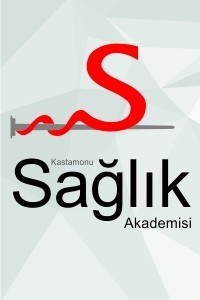BASINÇ YARASININ ÖNLENMESİNDE HEMŞİRELERİN BİLGİ DÜZEYLERİNİN İNCELENMESİ
Basınç yarası, önleme, bilgi düzeyi, hemşirelik
___
- Kaynaklar
- Ayello, E.A. and Meaney, G. (2003). Replicating a survey of pressure ulcer content textbooks. Journal of Wound Ostomy Continence Nursing, 30(5), 266-271.
- Black, J., Baharestani, M. and Cuddigan, J. (2007). Natioanal Pressure Ulcer Advisory Panel’s updated pressure ulcer staging system. Advanced & Skin Wound Care,20(5), 269-274.
- Graves, N., Birrell, F. and Whitby, M. (2005). Effect of pressure ulcers on length of hospital stay. Infection Control Hospital Epidemiology, 26(3), 293-297 .
- Scott, J.R., Gibran, N.S., Engrav, L.H., Mack, C.D., and Rivara, F.P. (2006). Incidence and characteristics of hospitalized patients with pressure ulcers: State of Washington, 1987 to 2000 . Plastic Reconstructive Surgery, 117(2), 630-634.
- Olsho, L.E.W., Spector, W.D., Williams, C.S., Rhodes, W., Fink, R.V., Limcangco, R. and Hurd, D. (2014). Evaluation of AHRQ’s on-time pressure ulcer prevention program. Medical Care, 52, 258–266.
- Hommel, A., Ulander, K.and Thorngren, K. (2003). Improvements in pain relief, handling time and pressure ulcers through internal audits of hip fracture patients. Scand Journal Caring Science, 17, 78-83.
- Wurster, J. (2007). What role can nurse leaders play in reducing the incidence of pressure sores? Nursing Economics,25 (5),267-269.
- Nuru, N., Zewdu, F., Amsalu, S. and Mehretie, Y. (2015). Knowledge and practice of nurses towards prevention of pressure ulcer and associated factors in Gondar University Hospital, Northwest Ethiopia. BMC Nursing, 14, 34.
- Kallman, U. and Suserud, B.O. (2009). Knowledge, attitudes and practice among nursing staff concerning pressure ulcer prevention and treatment: a survey in a Swedish healthcare setting. Scandinavian Journal of Caring Sciences, 23, 334–341.
- Pancorbo-Hidalgo, P.L., Garcia-Fernandez, F.P., Lopez-Medina, I.M., and Lopez-Ortega, J. (2007). Pressure ulcer care in Spain: nurses’ knowledge and clinical practice. Journal of Advanced Nursing, 58(4), 327–338.
- Gunningberg, L. (2005). Are patients with or at risk of pressure ulcers allocated appropriate prevention measures? International Journal of Practice,11, 58–67.
- Sinclair, L., Berwiczonek, H., Thurston, N., Butler, S., Bulloch, G., Ellery, C. and Giesbrecht, G. (2004). Evaluation of an evidence-based education program for pressure ulcer prevention. Journal of Wound and Ostomy Continence Nursing,31(1), 43–50.
- Ayello, E. and Lyder, C.H. (2008). A new era of pressure ulcer accountability in acute care. Advances in Skin and Wound Care,21, 134–140.
- Tweed, C. and Tweed, M. (2008). Intensive care nurses’ knowledge of pressure ulcers: Development of an assessment tool and effect of an educational program. American Journal of Critical Care,17, 338–347.
- Qaddumi, J. and Khawaldeh, A. (2014). Pressure ulcer prevention knowledge among Jordanian nurses: a crosssectional study. BMC Nursing, 13(6).
- Abou El Enein, N.Y. and Zaghloul. A.A. (2011). Nurses’ knowledge of prevention and management of pressure ulcer at a Health Insurance Hospital in Alexandria. International Journal of Nursing Practice, 17(3), 262–268.
- Demarre, L., Vanderwee, K., Defloor, T., Verhaeghe, S., Schoonhoven, L. and Beeckman, D. (2012). Pressure ulcers: knowledge and attitude of nurses and nursing assistants in Belgian nursing homes. Journal of Clinical Nursing, 21, 1425–1434.
- Beeckman, D., Defloor, T., Schoonhoven, L. and Vanderwee, K. (2011). Knowledge and attitudes of nurses on pressure ulcer prevention: A cross-sectional multicenter study in Belgian hospitals. Worldviews on Evidence-Based Nursing, 8, 166–176.
- Buss, I.C., Halfens, R.J., Abu-Saad, H.H. and Kok, G. (2004). Pressure ulcer prevention in nursing homes: Views and beliefs of enrolled nurses and other health care workers. Journal of Clinical Nursing,13, 668–676.
- Panagiotopoulou, K. and Kerr, S.M. (2002). Pressure area care: an exploration of Greek nurses’ knowledge and practice. Journal of Advanced Nursing, 40, 285–296.
- Meesterberends, E., Wilborn, D., Lohrmann, C., Schols, J. and Halfens, R. (2013). Knowledge and use of pressure ulcer preventive measures in nursing homes: a comparison of Dutch and German nursing staff. Journal of Clinical Nursing, 23, 1948–1958.
- Miyazaki, M.Y., Caliri, M.H. and Santos, C.B. (2010). Knowledge on pressure ulcer prevention among nursing professionals. Revista Latino-Americana de Enfermagem, 18, 1203–1211.
- National Pressure Ulcer Advisory Panel, European Pressure Ulcer Advisory Panel and Pan Pacific Pressure Injury Alliance. Prevention and Treatment of Pressure Ulcers: Quick Reference Guide. Australia; 2014.
- Hulsenboom, M.A., Bours, G.J. and Halfens, R.J. (2007). Knowledge of pressure ulcer prevention: across-sectional and comparative study among nurses. BioMedical Central Nursing, 6(2), 1–11.
- Yayın Aralığı: Yılda 3 Sayı
- Başlangıç: 2016
- Yayıncı: Esra DEMİRARSLAN
Üniversite Öğrencilerinin Sağlıklı Yaşam Biçimi Davranışlarının Belirlenmesi
Nevin ÇITAK BİLGİN, Bedriye AK, Birgül CERİT, Melike ERTEM, Gülseren ÇITAK TUNÇ
BASINÇ YARASININ ÖNLENMESİNDE HEMŞİRELERİN BİLGİ DÜZEYLERİNİN İNCELENMESİ
Tuba YILMAZER, Hilal TÜZER, Ayşegül TARLA
HZ PEYGAMBER DÖNEMİNDE HASTABAKICI KADINLAR: İLK MÜSLÜMAN HEMŞİRELER
